Microstructure and Mechanical Properties of Carbide Reinforced TiC-Based Ultra-High Temperature Ceramics: A Review
Abstract
:1. Introduction
2. Properties of TiC Based Ceramics
| Attribute | TiC | ZrC | NbC | HfC | TaC |
|---|---|---|---|---|---|
| Crystal structure | FCC | FCC | FCC | FCC | FCC |
| Space group | Fm-3m 225 | Fm-3m 225 | Fm-3m 225 | Fm-3m 225 | Fm-3m 225 |
| Lattice parameters (nm) | a = 0.46000, | a = 0.46960, | a = 0.44000, | a = 0.46410, | a = 0.44460, |
| b = 0.46000, | b = 0.46960, | b = 0.44000, | b = 0.46410, | b = 0.44460, | |
| c = 0.46000 | c = 0.46960 | c = 0.44000 | c = 0.46410 | c = 0.44460 | |
| Resistivity (μΩ·cm) | 68 | 63 | 74 | 109 | 30 |
| Thermal conductivity (W/m·K) | 21 | 20.5 | 14 | 20 | - |
| Theoretical density (g/cm3) | 4.94 | 6.73 | 7.6 | 12.7 | 14.3 |
| Melting point (°C) | 3140 | 3540 | 3500 | 3890 | 3880 |
| Vickers hardness (GPa) | 25.1 | 27 | 20 | 26 | 14-19 |
| Coefficient of thermal expansion (10−6 K−1) | 7.74 | 6.7 | 6.65 | 6.73 | 8.3 |
| Modulus of elasticity (GPa) | 451 | 480 | 338 | 300~400 | 470~540 |
| Fracture toughness (MPam1/2) | 5.1 | 2 | - | - | 3.4 |
| Bending strength (MPa) | 240–400 | 400 | - | 250–350 | 600–700 |
3. Effects of Secondary Phase on Microstructure and Mechanical of TiC
3.1. Effect of Particle Phase on TiC Matrix Composites
3.2. Effect of Whiskers on TiC Matrix Composites
3.3. Effect of Carbon Manotubes on TiC Matrix Composites
4. Summary and Outlook
Author Contributions
Funding
Institutional Review Board Statement
Informed Consent Statement
Data Availability Statement
Acknowledgments
Conflicts of Interest
References
- Fu, T.; Cui, K.K.; Zhang, Y.Y.; Wang, J.; Shen, F.Q.; Yu, L.H.; Qie, J.M.; Zhang, X. Oxidation protection of tungsten alloys for nuclear fusion applications: A comprehensive review. J. Alloys Compd. 2021, 884, 161057. [Google Scholar] [CrossRef]
- Zhang, Y.Y.; Yu, L.H.; Fu, T.; Wang, J.; Shen, F.Q.; Cui, K.K. Microstructure evolution and growth mechanism of Si-MoSi2 composite coatings on TZM (Mo-0.5Ti-0.1Zr-0.02 C) alloy. J. Alloys Compd. 2022, 894, 162403. [Google Scholar]
- Zhang, Y.Y.; Cui, K.K.; Fu, T.; Wang, J.; Shen, F.Q.; Zhang, X.; Yu, L.H. Formation of MoSi2 and Si/MoSi2 coatings on TZM (Mo-0.5Ti-0.1Zr-0.02C) alloy by hot dip silicon-plating method. Ceram. Int. 2021, 47, 23053–23065. [Google Scholar] [CrossRef]
- Zhai, W.; Zhou, W.; Nai, S.M.L. In-situ formation of TiC nanoparticles in selective laser melting of 316L with addition of micronsized TiC particles. Mater. Sci. Eng. A 2021, 829, 142179. [Google Scholar] [CrossRef]
- Wang, B.; Zhang, Y.; Qiu, F.; Hu, M.; Cui, W.; Hu, Z.; Barber, C. Simultaneously Enhanced Hardness and Toughness of Normalized Graphite Ductile Irons by TiC-TiB2 Nanoparticles. Mater. Lett. 2021, 291, 129597. [Google Scholar] [CrossRef]
- Nguyen, V.H.; Delbari, S.A.; Asl, M.S.; Le, Q.V.; Shokouhimehr, M.; Namini, A.S.; Mohammadi, M. Microstructure-property correlation in nano-diamond and TiN added TiC-based ceramics. Ceram. Int. 2021, 47, 449–460. [Google Scholar] [CrossRef]
- Shen, L.; Zhao, Y.; Li, Y.; Wu, H.; Zhu, H.G.; Xie, Z.H. Synergistic strengthening of FeCrNiCo high entropy alloys via micro-TiC and nano-SiC particles. Mater. Today Commun. 2021, 26, 101729. [Google Scholar] [CrossRef]
- Gholizadeh, T.; Vajdi, M.; Rostamzadeh, H. A new trigeneration system for power, cooling, and freshwater production driven by a flash-binary geothermal heat source. Renew. Energy 2020, 148, 31–43. [Google Scholar] [CrossRef]
- Cui, K.K.; Zhang, Y.Y.; Fu, T.; Wang, J.; Zhang, X. Toughening Mechanism of Mullite Matrix Composites: A Review. Coatings 2020, 10, 672. [Google Scholar] [CrossRef]
- Asl, M.S.; Kakroudi, M.G. Characterization of hot-pressed graphene reinforced ZrB2-SiC composite. Mater. Sci. Eng. 2015, 625, 385–392. [Google Scholar]
- Ramos, J.P.; Senos, A.; Stora, T.; Fernandes, C.M.; Bowen, P. Development of a processing route for carbon allotrope-based TiC porous nanocomposites. J. Eur. Ceram. Soc. 2018, 37, 3899–3908. [Google Scholar] [CrossRef]
- Ocak, B.C.; Yavas, B.; Akin, I.; Sahin, F.; Goller, G. Spark plasma sintered ZrC-TiC-GNP composites: Solid solution formation and mechanical properties. Ceram. Int. 2017, 44, 2336–2344. [Google Scholar] [CrossRef]
- Cabrero, J.; Audubert, F.; Pailler, R. Fabrication and characterization of sintered TiC-SiC composites. Eur. Ceram. Soc. 2011, 32, 313–320. [Google Scholar] [CrossRef]
- Kang, B.; Putri, W.; Kang, W.N. Effect of SiC buffer layer on flux pinning property of MgB2 tapes. Curr. Appl. Phys. 2019, 19, 670–674. [Google Scholar] [CrossRef]
- Qi, L.; Li, S.; Zhang, T.; Zhou, J. An analysis of the factors affecting strengthening in carbon fiber reinforced magnesium composites. Compos. Struct. 2019, 209, 328–336. [Google Scholar] [CrossRef]
- Sribalaji, M.; Mukherjee, B.; Bakshi, S.R.; Arunkumar, P.; Babu, K.S.; Keshri, A.K. In-situ formed graphene nanoribbon induced toughening and thermal shock resistance of spark plasma sintered carbon nanotube reinforced titanium carbide composite. Compos. Part. B Eng. 2017, 123, 227–240. [Google Scholar] [CrossRef]
- Zhao, Z.; Yu, X.; Wang, L.; Yao, S.; Song, X.; Qi, Q. Effect of Ni on the formation mechanism of TiC/Ni composites fabricated by reactive sintering. Int. J. Refract. Met. Hard Mater. 2021, 100, 105611. [Google Scholar] [CrossRef]
- Wang, D.; Cao, X.; Liu, J.; Zhang, Z.; Jin, X.; Gao, J.; Yu, H.; Sun, S.; Li, F. TF-Al/TiC highly reactive composite particle for application potential in solid propellants. Chem. Eng. J. 2021, 425, 130674. [Google Scholar] [CrossRef]
- He, J.; Zheng, G.; Guo, F.; Fu, G.; Li, C.; Zhao, H.; Qin, Y.; Jiang, Y.; Yin, F. Microstructure and tribological properties of in-situ synthesized TiC reinforced reactive plasma sprayed Co-based coatings. Mater. Chem. Phys. 2020, 248, 122913. [Google Scholar] [CrossRef]
- Hu, W.; Du, Z.; Dong, Z.; Yu, L.; Ahamad, T.; Ma, Z. The synthesis of TiC dispersed strengthened Mo alloy by freeze-drying technology and subsequent low temperature sintering. Scr. Mater. 2021, 198, 113831. [Google Scholar] [CrossRef]
- Pan, X.; Niu, Y.; Liu, T.; Liu, T.; Zhong, X.; Li, C.; Shi, M.; Zheng, X.; Ding, C. Ablation behaviors of ZrC-TiC coatings prepared by vacuum plasma spray: Above 2000 °C. J. Eur. Ceram. Soc. 2019, 39, 3292–3300. [Google Scholar] [CrossRef]
- Cheng, L.X.; Xie, Z.P.; Liu, G.W. Spark plasma sintering of TiC ceramic with tungsten carbide as a sintering additive. J. Eur. Ceram. Soc. 2013, 33, 2971–2977. [Google Scholar] [CrossRef]
- Zhu, Q.; Shang, X.; Zhang, H.; Qi, X.; Li, Y.; Zeng, X. Influence of Al2Y particles on mechanical properties of Mg-11Y-1Al alloy with different grain sizes. Mater. Sci. Eng. A 2022, 831, 142166. [Google Scholar] [CrossRef]
- Zeng, X.; Wang, Q.; Chen, C.; Lian, G.; Huang, X. Effects of WC addition on the morphology, microstructure and mechanical properties of Fe50/TiC/WC laser claddings on AISI 1045 steel. Surf. Coat. Technol. 2021, 427, 127781. [Google Scholar] [CrossRef]
- Zhang, W.; Yi, P.; Peng, L.; Lai, X. Strategy of alternating bias voltage on corrosion resistance and interfacial conductivity enhancement of TiCx/a-C coatings on metallic bipolar plates in PEMFCs. Energy 2018, 162, 933–943. [Google Scholar] [CrossRef]
- Heidarpour, A.; Aghamohammadi, H.; Jamshidi, R.; Ghasemi, S. The shape evolution of TiCx prepared by mechanical alloying of Ti-Al-C system after HF treatment. Ceram. Int. 2018, 45, 4653–4660. [Google Scholar] [CrossRef]
- Jin, S.B.; Shen, P.; Lin, Q.L.; Zhan, L.; Jiang, Q.C. Growth Mechanism of TiCx during Self-Propagating High-Temperature Synthesis in an AlTiC System. Cryst. Growth Des. 2010, 10, 1590–1597. [Google Scholar] [CrossRef]
- Zarrinfar, N.; Shipway, P.H.; Kennedy, A.R.; Saidi, A. Carbide stoichiometry in TiCx and Cu-TiCx produced by self-propagating high-temperature synthesis. Scr. Mater. 2002, 46, 121–126. [Google Scholar] [CrossRef]
- Nie, J.F.; Liu, X.F.; Ma, X.G. Influence of trace boron on the morphology of titanium carbide in an Al-Ti-C-B master alloy. J. Alloys Compd. 2010, 491, 113–117. [Google Scholar] [CrossRef]
- Ren, L.; Gao, T.; Nie, J.; Liu, G.; Liu, X. A novel core-shell TiCxparticle by modifying TiCx with B element and the preparation of the (TiCx+AlN)/Al composite. J. Alloys Compd. 2022, 894, 162448. [Google Scholar] [CrossRef]
- Dong, B.X.; Yang, H.Y.; Qiu, F.; Li, Q.; Shu, S.L.; Zhang, B.Q.; Jiang, Q.C. Design of TiC nanoparticles and their morphology manipulating mechanisms by stoichiometric ratios: Experiment and first-principle calculation. Mater. Des. 2019, 181, 107951. [Google Scholar] [CrossRef]
- Zhang, D.D.; Liu, H.L.; Sun, L.P.; Bai, F.; Wang, Y.; Wang, J.G. Shape-Controlled TiCx Particles Fabricated by Combustion Synthesis in the Cu-Ti-C System. Crystals 2017, 7, 205. [Google Scholar] [CrossRef]
- Meng, Y.; Hu, H.Q. In situ laser surface coating of TiC metal-matrix composite layer. J. Mater. Sci. 1996, 31, 4303–4306. [Google Scholar]
- Guo, X.; Zheng, Y.; Zhang, G.; Wu, H.; Yang, Z.; Gong, A. Microstructure and mechanical properties of TiC steel-bonded carbides prepared by two-step sintering technique. Int. J. Refract. Met. Hard Mater. 2020, 93, 105342. [Google Scholar] [CrossRef]
- Hu, W.; Kong, X.; Du, Z.; Khan, A.; Ma, Z. Synthesis and characterization of nano TiC dispersed strengthening W alloys via freeze-drying. J. Alloys Compd. 2020, 859, 157774. [Google Scholar] [CrossRef]
- Golla, B.R.; Mukhopadhyay, A.; Basu, B.; Thimmappa, S.K. Review on Ultra High Temperature Boride Ceramics. Prog. Mater. Sci. 2020, 111, 100651. [Google Scholar] [CrossRef]
- Li, H.; Zhang, L.; Cheng, L.; Wang, Y. Fabrication of 2D C/ZrC-SiC composite and its structural evolution under high-temperature treatment up to 1800 °C. Ceram. Int. 2009, 35, 2831–2836. [Google Scholar] [CrossRef]
- He, R.; Li, K.; Liu, Q. High-temperature phase composition, crystal stabilisation, and interfacial diffusion of (NbC-ZrC)/SiC double-layer coated C/C composites enduring the oxyacetylene flame. Corros. Sci. 2021, 188, 109541. [Google Scholar] [CrossRef]
- Liu, X.S.; Liu, M.; Zhao, X.M.; Li, R.; Sun, B.Z.; Qi, Y.; Song, J.P. Investigations on microstructure and mechanical properties of HfC particle-reinforced W Mo composites. Int. J. Refract. Met. Hard Mater. 2021, 100, 105634. [Google Scholar] [CrossRef]
- Zhao, T.; Chen, P.; Zhang, L.; Zhang, L.; Gao, Y.; Ai, S.; Liu, H.; Liu, X. Heterotrophic nitrification and aerobic denitrification by a novel Acinetobacter sp. TAC-1 at low temperature and high ammonia nitrogen. Bioresour. Technol. 2021, 339, 125620. [Google Scholar] [CrossRef] [PubMed]
- Fattahi, M.; Delbari, S.A.; Babapoor, A.; Namini, A.S.; Mohammadi, M.; Asl, M.S. Triplet carbide composites of TiC, WC, and SiC. Ceram. Int. 2019, 46, 9070–9078. [Google Scholar] [CrossRef]
- Asl, M.S.; Ahmadi, Z.; Namini, A.S.; Babapoor, A. Spark plasma sintering of TiC-SiCw ceramics. Ceram. Int. 2019, 45, 19808–19821. [Google Scholar]
- Foong, L.K.; Mu'azu, M.A.; Lyu, Z.J. Effect of SiC whisker on densification and mechanical properties of hot-pressed TiC-based composites. Ceram. Int. 2020, 46, 27734–27741. [Google Scholar] [CrossRef]
- Fattahi, M.; Mohammadzadeh, A.; Pazhouhanfar, Y.; Shaddel, S.; Asl, M.S.; Namini, A.S. Influence of SPS temperature on the properties of TiC-SiCw composites. Ceram. Int. 2020, 46, 11735–11742. [Google Scholar] [CrossRef]
- Foong, L.K.; Jume, B.H.; Xu, C.Y. Densification behavior and mechanical properties of hot-pressed TiC-WC ceramics. Ceram. Int. 2020, 46, 28316–28323. [Google Scholar] [CrossRef]
- Fattahi, M.; Asl, M.S.; Delbari, S.A.; Namini, A.S.; Ahmadi, Z.; Mohammadi, M. Role of nano-WC addition on microstructural, mechanical and thermal characteristics of TiC-SiCw composites. Int. J. Refract. Met. Hard Mater. 2020, 90, 105248. [Google Scholar] [CrossRef]
- Cheng, L.X.; Xie, Z.P.; Liu, G.W. Spark plasma sintering of TiC-based composites toughened by submicron SiC particles. Ceram. Int. 2013, 39, 5077–5082. [Google Scholar] [CrossRef]
- Nguyen, T.P.; Pazhouhanfar, Y.; Delbari, S.A.; Le, Q.V.; Shaddel, S.; Namini, A.S.; Shokouhimehr, M.; Asl, M.S. Role of nano-diamond addition on the characteristics of spark plasma sintered TiC ceramics. Diam. Relat. Mater. 2020, 106, 107828. [Google Scholar] [CrossRef]
- Nguyen, V.H.; Pazhouhanfar, Y.; Delbari, S.A.; Shaddel, S.; Babapoor, A.; Mohammadpourderakhshi, Y.; Le, Q.V.; Shokouhimehr, M.; Asl, M.S.; Namini, A.S. Beneficial role of carbon black on the properties of TiC ceramics. Ceram. Int. 2020, 46, 23544–23555. [Google Scholar] [CrossRef]
- Magnus, C.; Kwamman, T.; Rainforth, W.M. Dry Sliding Friction and Wear Behaviour of TiC-Based Ceramics and Consequent Effect of the Evolution of Grain Buckling on Wear Mechanism. Wear 2019, 422, 54–67. [Google Scholar] [CrossRef]
- Foong, L.K.; Lyu, Z. Sintering and mechanical behavior of SiC and WC co-added TiC-based composites densified by hot-pressing. Ceram. Int. 2020, 47, 6479–6486. [Google Scholar] [CrossRef]
- Jiang, J.; Li, S.; Hu, S.; Zhang, J.; Zhou, Y. Comparison of high Cr white iron composites reinforced with directly added TiC and in situ formed TiCx. J. Mater. Res. Technol. 2020, 9, 3140–3148. [Google Scholar] [CrossRef]
- Sribalaji, M.; Singh, D.; Singh, S.; Islam, A.; Pandey, M.K.; Viswanath, B.; Keshri, A.K. A new insight on the role of 1-D and 2-D reinforcements in TiC during high temperature plastic deformation. Ceram. Int. 2018, 44, 18389–18399. [Google Scholar] [CrossRef]
- Sribalaji, M.; Mukherjee, B.; Islam, A.; Keshri, A.K. Microstructural and mechanical behavior of spark plasma sintered titanium carbide with hybrid reinforcement of tungsten carbide and carbon nanotubes. Mater. Sci. Eng. A 2017, 702, 10–21. [Google Scholar] [CrossRef]
- Fattahi, M.; Babapoor, A.; Delbari, S.A.; Ahmadi, Z.; Namini, A.S.; Asl, M.S. Strengthening of TiC ceramics sintered by spark plasma via nano-graphite addition. Ceram. Int. 2020, 46, 12400–12408. [Google Scholar] [CrossRef]
- Nguyen, V.H.; Delbari, S.A.; Namini, A.S.; Babapoor, A.; Le, Q.V.; Jang, H.W.; Shokouhimehr, M.; Asl, M.S. Microstructural, mechanical and friction properties of nano-graphite and h-BN added TiC-based composites. Ceram. Int. 2020, 46, 28969–28979. [Google Scholar] [CrossRef]
- Nguyen, T.P.; Pazhouhanfar, Y.; Delbari, S.A.; Le, Q.V.; Shaddel, S.; Pazhouhanfar, M.; Shokouhimehr, A.S.N.M.; Asl, M.S. Characterization of spark plasma sintered TiC ceramics reinforced with graphene nano-platelets. Ceram. Int. 2020, 46, 18742–18749. [Google Scholar] [CrossRef]
- Istgaldi, H.; Asl, M.S.; Shahi, P.; Nayebi, B.; Ahmadi, Z. Solid solution formation during spark plasma sintering of ZrB2-TiC-graphite composites. Ceram. Int. 2020, 46, 2923–2930. [Google Scholar] [CrossRef]
- Nguyen, V.H.; Delbari, S.A.; Asl, M.S.; Le, Q.V.; Jang, H.W.; Shokouhimehr, M.; Mohammadi, M.; Namini, A.S. A novel TiC-based composite co-strengthened with AlN particulates and graphene nano-platelets. Int. J. Refract. Met. Hard Mater. 2020, 92, 105331. [Google Scholar] [CrossRef]
- Moghanlou, F.S.; Vajdi, M.; Jafarzadeh, H.; Ahmadi, Z.; Motallebzadeh, A.; Sharifianjazi, F.; Asl, M.S.; Mohammadi, M. Spark plasma sinterability and thermal diffusivity of TiN ceramics with graphene additive. Ceram. Int. 2020, 47, 10057–10062. [Google Scholar] [CrossRef]
- Asl, M.S.; Nayebi, B.; Akhlaghi, M.; Ahmadi, Z.; Tayebifard, S.A.; Salahi, E.; Shokouhimehr, M.; Mohammadi, M. A novel ZrB2-based composite manufactured with Ti3AlC2 additive. Ceram. Int. 2021, 47, 817–827. [Google Scholar]
- Kayali, E.; Mercan, E.; Oren, E.E.; Buke, G.C. Few layer graphene synthesis via SiC decomposition at low temperature and low vacuum. J. Phys. D Appl. Phys. 2016, 49, 165301. [Google Scholar] [CrossRef]
- Funatsu, M.; Ozawa, M.; Shirai, H.H.; Takakusagi, F. Experimental Study of Ablation Processes of SiC-based Materials in Air Plasma Freejets. Trans. Jpn. Soc. Aeronaut. Space Sci. Aerosp. Technol. Jpn. 2010, 8, 41–46. [Google Scholar] [CrossRef]
- Yuan, G.; Cong, Q.; Chen, Z.; Xie, B. Phase Analysis of Laser Direct Etching and Water Assisted Laser Combined Etching of SiC Ceramics. Lasers Manuf. Mater. Process. 2017, 4, 168–177. [Google Scholar] [CrossRef]
- Yan, W.; Zhang, Y.; Chen, L.; Luo, J.; Pang, P.; Zhang, X.; Liao, B.; Ying, M. Corrosion behavior and interfacial conductivity of amorphous hydrogenated carbon and titanium carbide composite (a-C: H/TiC) films prepared on titanium bipolar plates in PEMFCs. Diam. Relat. Mater. 2021, 120, 108628. [Google Scholar] [CrossRef]
- Kierstin, D.; Kanani, L. High-Pressure, High-Temperature Behavior of Silicon Carbide: A Review. Crystals 2018, 8, 217. [Google Scholar]
- Cao, Y.; He, Q.; Wang, W. Microstructure, Mechanical, and Thermal Properties of B4C-TiB2-SiC Composites Prepared by Reactive Hot-pressing. J. Wuhan Univ. Technol.-Mater. Sci. 2020, 35, 1031–1037. [Google Scholar] [CrossRef]
- Nguyen, T.P.; Mahaseni, Z.H.; Germi, M.D.; Delbari, S.A.; Le, Q.V.; Ahmadi, Z.; Shokouhimehr, M.; Asl, M.S.; Namini, A.S. Densification behavior and microstructure development in TiB2 ceramics doped with h-BN. Ceram. Int. 2020, 46, 18970–18975. [Google Scholar] [CrossRef]
- Vajdi, M.; Moghanlou, F.S.; Sharifianjazi, F.; Asl, M.S.; Shokouhimehr, M. A review on the Comsol Multiphysics studies of heat transfer in advanced ceramics. J. Compos. Compd. 2020, 2, 35–43. [Google Scholar] [CrossRef]
- Sakkaki, M.; Moghanlou, F.S.; Parvizi, S.; Baghbanijavid, H.; Babapoor, A.; Asl, M.S. Phase change materials as quenching media for heat treatment of 42CrMo4 steels. J. Cent. South. Univ. 2020, 27, 752–761. [Google Scholar] [CrossRef]
- Li, C.; Zhou, Z.; Hu, L.; He, J.; Zheng, G.; Zhao, H.; Dong, Y.; Yang, Y.; Qin, Y.; Yin, F. Fabrication of plasma-sprayed TiC-Ti5Si3-Ti3SiC2 composite coatings from the annealed Ti/SiC powders. Surf. Coat. Technol. 2021, 417, 127227. [Google Scholar] [CrossRef]
- Luo, Y.; Li, S.; Wei, P. Fabrication and mechanical evaluation of SiC-TiC nanocomposites by SPS. Mater. Lett. 2004, 58, 150–153. [Google Scholar] [CrossRef]
- Wang, L.; Wan, J.; Chen, L. Rapidly sintering nanosized SiC particle reinforced TiC composites by the spark plasma sintering (SPS) technique. J. Mater. Sci. 2004, 39, 4515–4519. [Google Scholar] [CrossRef]
- Pan, C.; Gong, M.; Feng, S.; Chen, X.; Zhao, X.; He, P. Corrosion and thermal fatigue behaviors of induction-clad Ni-coated TiC particle-reinforced Ni60 coating in molten aluminum alloy. Surf. Coat. Technol. 2021, 419, 127278. [Google Scholar] [CrossRef]
- Wen, S.Y.; Du, Y.; Tan, J.; Liu, Y.; Zhou, P.; Long, J.Z.; Kaptay, G. A new model for thermal conductivity of “continuous matrix-dispersed and separated 3D-particles”type composite materials and its application to WC-M (M=Co, Ag) systems. J. Mater. Sci. Technol. 2022, 97, 123–133. [Google Scholar] [CrossRef]
- Huang, X.G.; Zhao, Z.M.; Zhang, L.; Wu, J.Y. The effects of ultra-high-gravity field on phase transformation and microstructure evolution of the TiC-TiB2 ceramic fabricated by combustion synthesis. Int. J. Refract. Met. Hard Mater. 2014, 43, 1–6. [Google Scholar] [CrossRef]
- Istgaldi, H.; Nayebi, B.; Ahmadi, Z.; Shahi, P.; Asl, M.S. Characterization of ZrB2-TiC composites reinforced with short carbon fibers. Ceram. Int. 2020, 46, 23155–23164. [Google Scholar] [CrossRef]
- Adibpur, F.; Tayebifard, S.A.; Zakeri, M.; Asl, M.S. Co-reinforcing of ZrB2-SiC ceramics with optimized ZrC to C f ratio. Ceram. Int. 2020, 46, 22661–22673. [Google Scholar] [CrossRef]
- Delbari, S.A.; Shakeri, M.S.; Salahshoori, I.; Asl, M.S.; Namini, A.S.; Abdolmaleki, A.; Sheikhlou, M.; Farvizi, M.; Jang, H.W.; Shokouhimehr, M. Characterization of TiC ceramics with SiC and/or WC additives using electron microscopy and electron probe micro-analysis. J. Taiwan Inst. Chem. Eng. 2021, 123, 245–253. [Google Scholar] [CrossRef]
- Zhang, Y.Y.; Cui, K.K.; Wang, J.; Wang, X.F.; Qie, J.M.; Xu, Q.Y.; Qi, Y.H. Effects of direct reduction process on the microstructure and reduction characteristics of carbon-bearing nickel laterite ore pellets. Powder Technol. 2020, 376, 496–506. [Google Scholar] [CrossRef]
- Wang, J.; Zhang, Y.Y.; Cui, K.K.; Fu, T.; Gao, J.J.; Hussain, S.; AlGarni, T.S. Pyrometallurgical recovery of zinc and valuable metals from electric arc furnace dust-A review. J. Clean. Prod. 2021, 298, 126788. [Google Scholar] [CrossRef]
- Pakdel, K.A.; Aghdam, R.M.; Asl, M.S.; Sani, M.A.F. Synthesis and morphology optimization of electrospun SiBNC nanofibers. Ceram. Int. 2020, 46, 6052–6059. [Google Scholar] [CrossRef]
- Gholizadeh, T.; Vajdi, M.; Rostamzadeh, H. Exergoeconomic optimization of a new trigeneration system driven by biogas for power, cooling, and freshwater production. Energy Convers. Manag. 2020, 205, 112417. [Google Scholar] [CrossRef]
- Vaferi, K.; Nekahi, S.; Vajdi, M.; Moghanlou, F.S.; Shokouhimehr, M.; Motallebzadeh, A.; Sha, J.j.; Asl, M.S. Heat transfer, thermal stress and failure analyses in a TiB2 gas turbine stator blade. Ceram. Int. 2019, 45, 19331–19339. [Google Scholar] [CrossRef]
- Gholizadeh, T.; Vajdi, M.; Rostamzadeh, H. A new biogas-fueled bi-evaporator electricity/cooling cogeneration system: Exergoeconomic optimization. Energy Convers. Manag. 2019, 196, 1193–1207. [Google Scholar] [CrossRef]
- Cui, K.K.; Zhang, Y.Y.; Fu, T.; Hussain, S.; AlGarni, T.S.; Wang, J.; Zhang, X. Effects of Cr2O3 Content on Microstructure and Mechanical Properties of Al2O3 Matrix Composites. Coatings 2021, 11, 234. [Google Scholar] [CrossRef]
- Jiang, C.C.; Goto, T.; Hirai, T. Microhardness of non-stoichiometric TiCx, plates prepared by chemical vapour deposition. J. Less Common Met. 1990, 163, 339–346. [Google Scholar] [CrossRef]
- Bakshi, S.R.; Musaramthota, V.; Virzi, D.A.; Keshri, A.K.; Lahiri, D.; Singh, V.; Seal, S.; Agarwal, A. Spark plasma sintered tantalum carbide-carbon nanotube composite: Effect of pressure, carbon nanotube length and dispersion technique on microstructure and mechanical properties. Mater. Sci. Eng. A 2011, 528, 2538–2547. [Google Scholar] [CrossRef]
- Nieto, A.; Lahiri, D.; Agarwal, A. Graphene NanoPlatelets reinforced tantalum carbide consolidated by spark plasma sintering. Mater. Sci. Eng. 2013, 582, 338–346. [Google Scholar] [CrossRef] [Green Version]
- Belmonte, M.; Nistal, A.; Boutbien, P.; Benito, R.M.; Osendi, M.I.; Miranzo, P. Toughened and Strengthened Silicon Carbide Ceramics by Adding Graphene-Based Fillers. Scr. Mater. 2016, 113, 127–130. [Google Scholar] [CrossRef]
- Yadhukulakrishnan, G.B.; Karumuri, S.; Rahman, A.; Singh, R.P.; Kalkan, A.K.; Harimkar, S.P. Spark plasma sintering of graphene reinforced zirconium diboride ultra-high temperature ceramic composites. Ceram. Int. 2013, 39, 6637–6646. [Google Scholar] [CrossRef]
- Zhang, Y.Y.; Cui, K.K.; Fu, T.; Wang, J.; Qie, J.M.; Zhang, X. Synthesis WSi2 coating on W substrate by HDS method with various deposition times. Appl. Surf. Sci. 2020, 511, 145551. [Google Scholar] [CrossRef]
- Zhang, Y.Y.; Fu, T.; Cui, K.K.; Shen, F.Q.; Wang, J.; Yu, L.H.; Mao, H.B. Evolution of surface morphology, roughness and texture of tungsten disilicide coatings on tungsten substrate. Vacuum 2021, 191, 110297. [Google Scholar] [CrossRef]

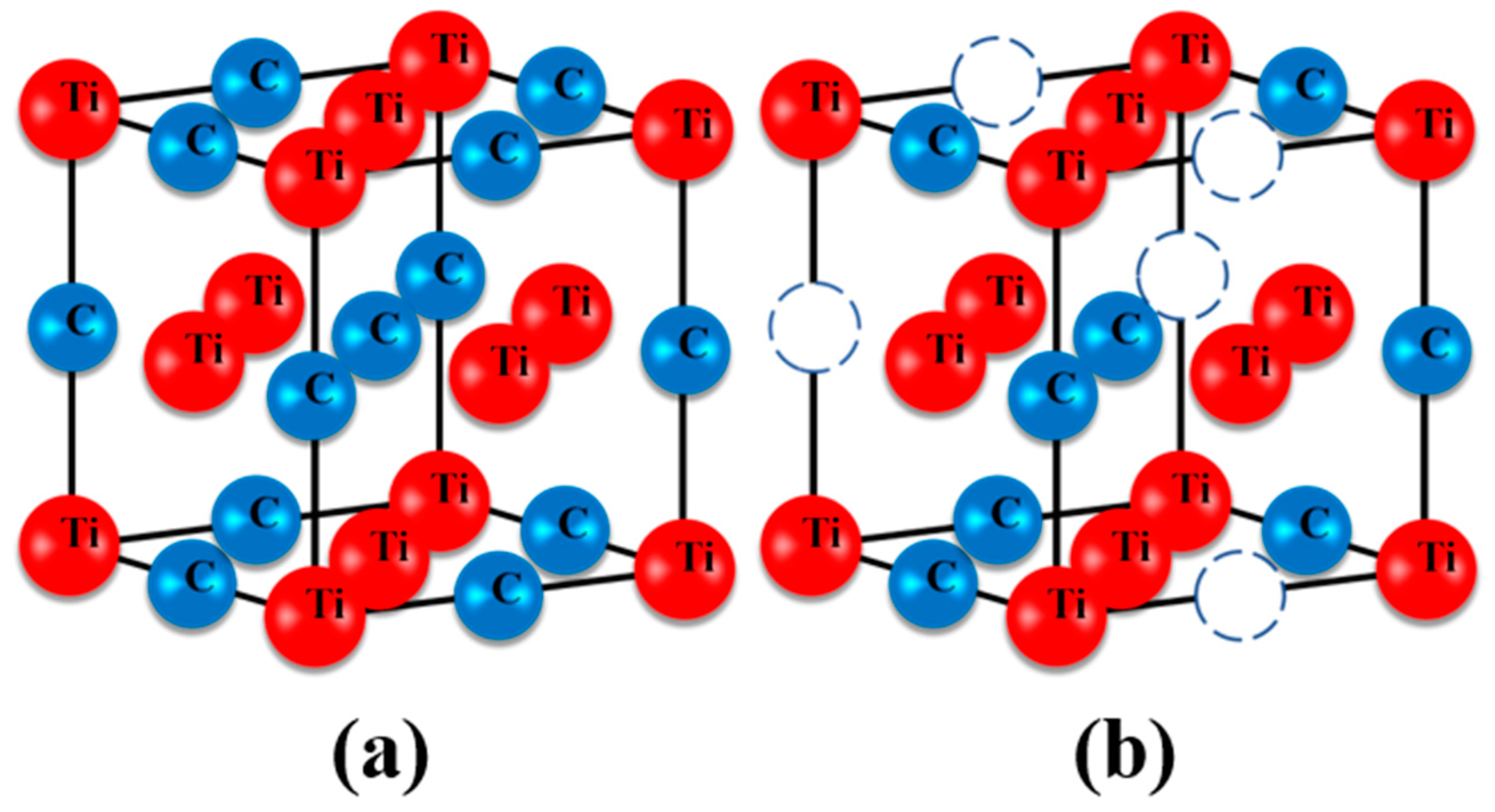
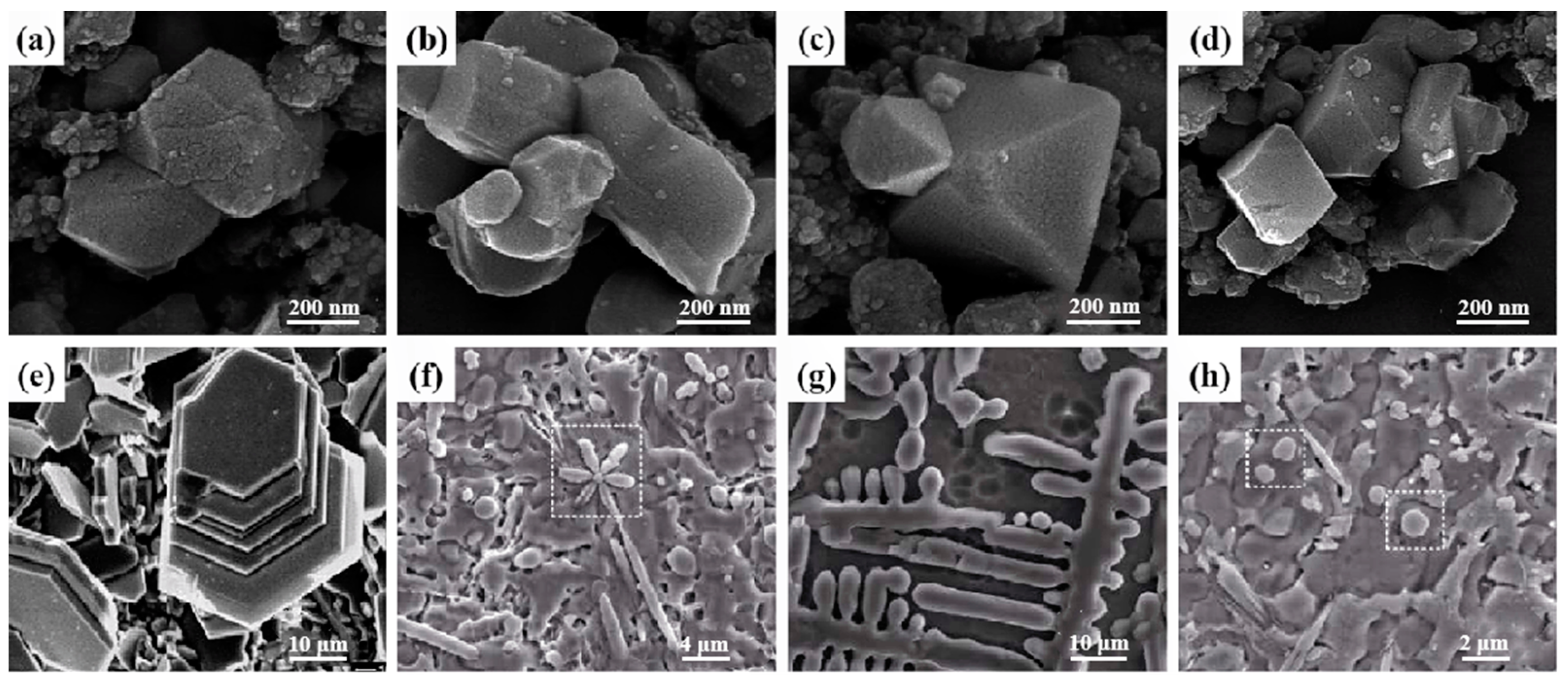
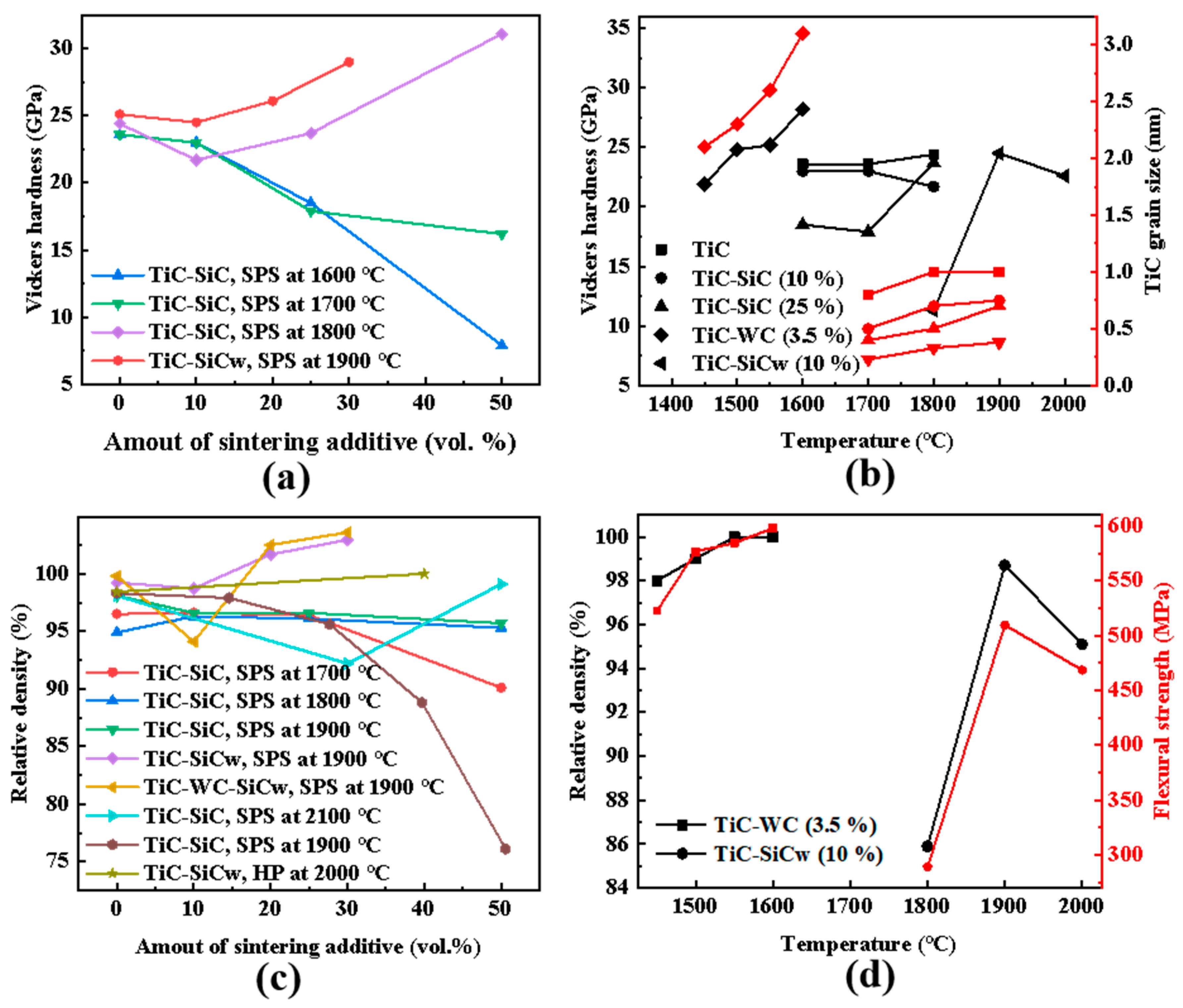
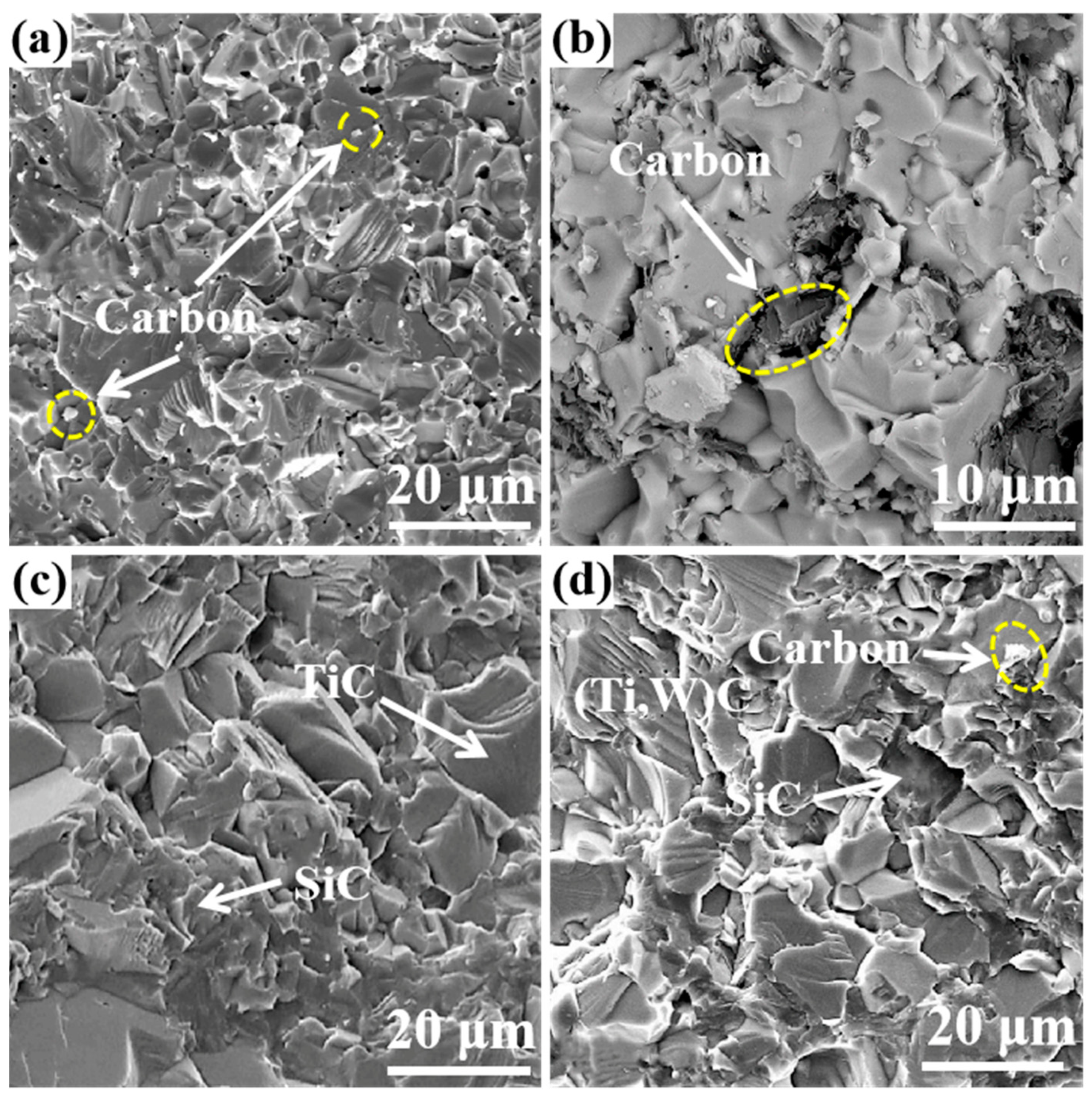

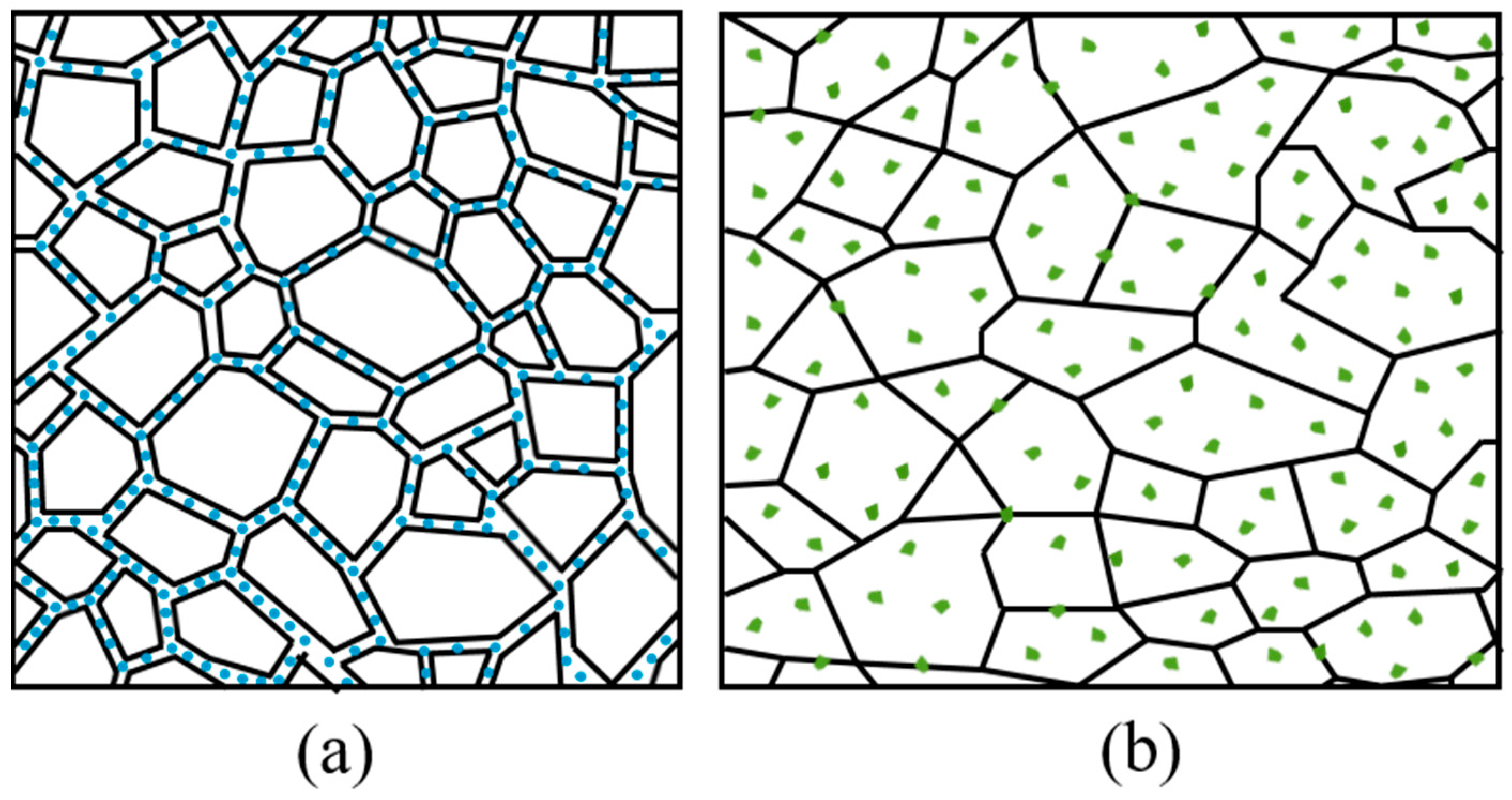

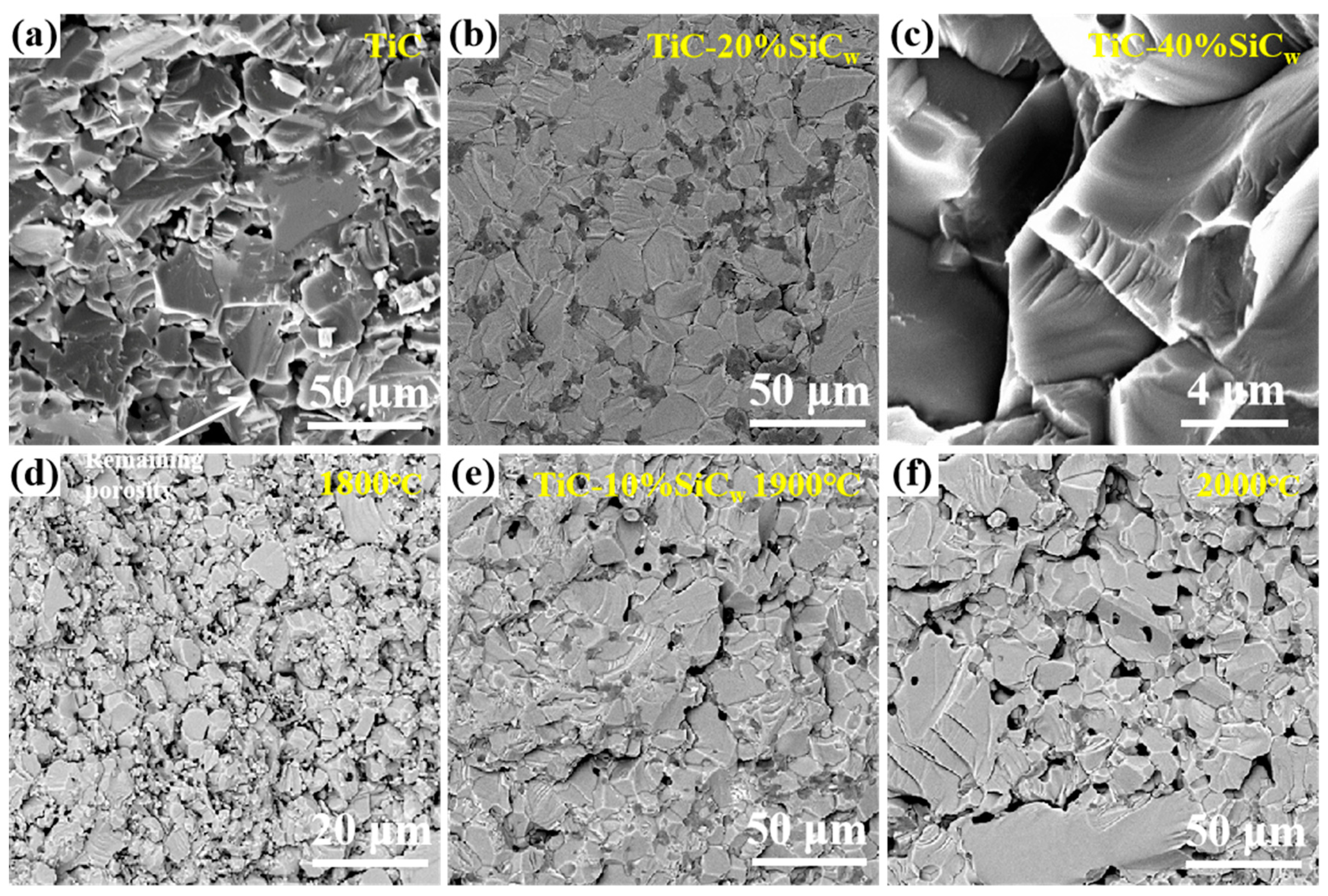
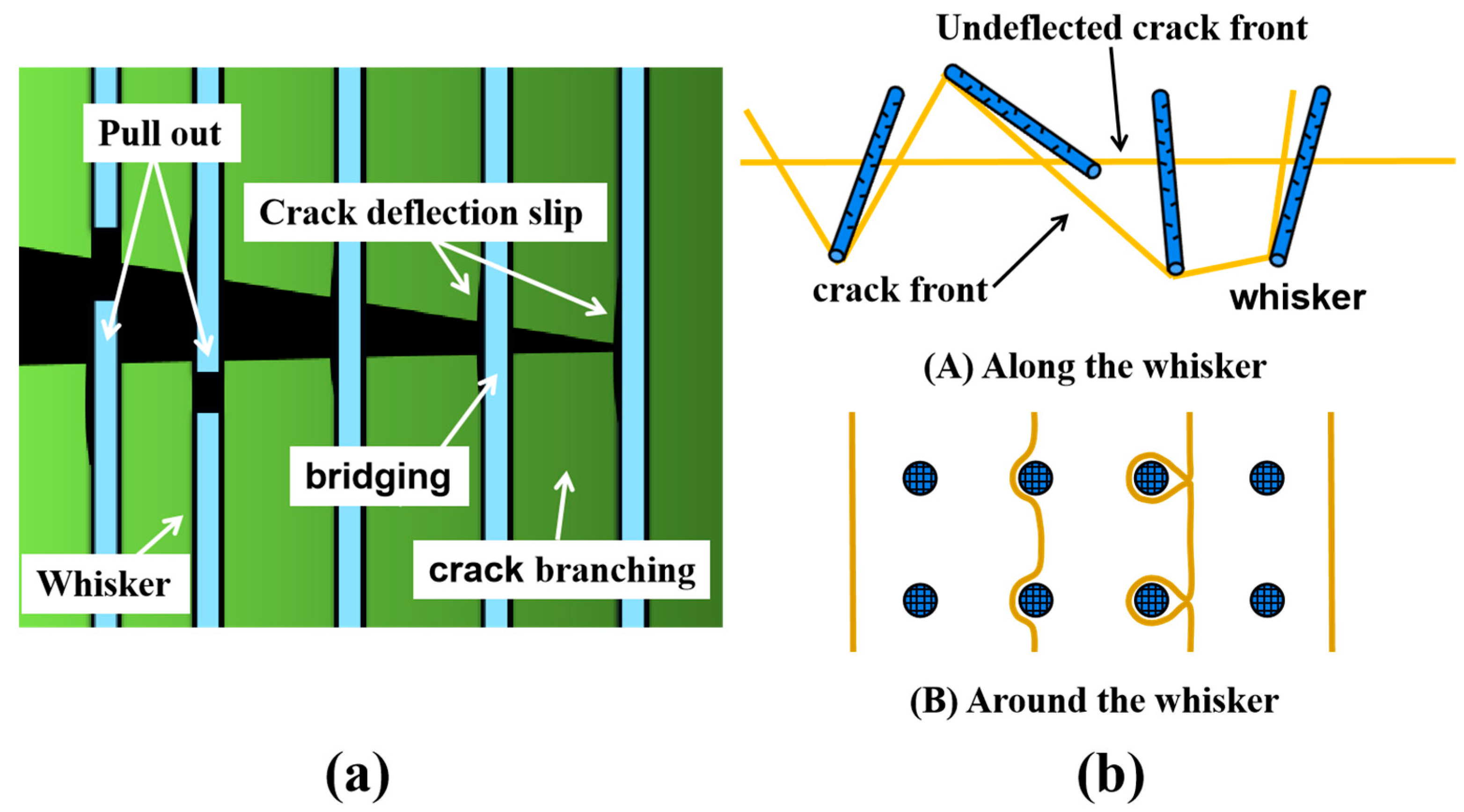

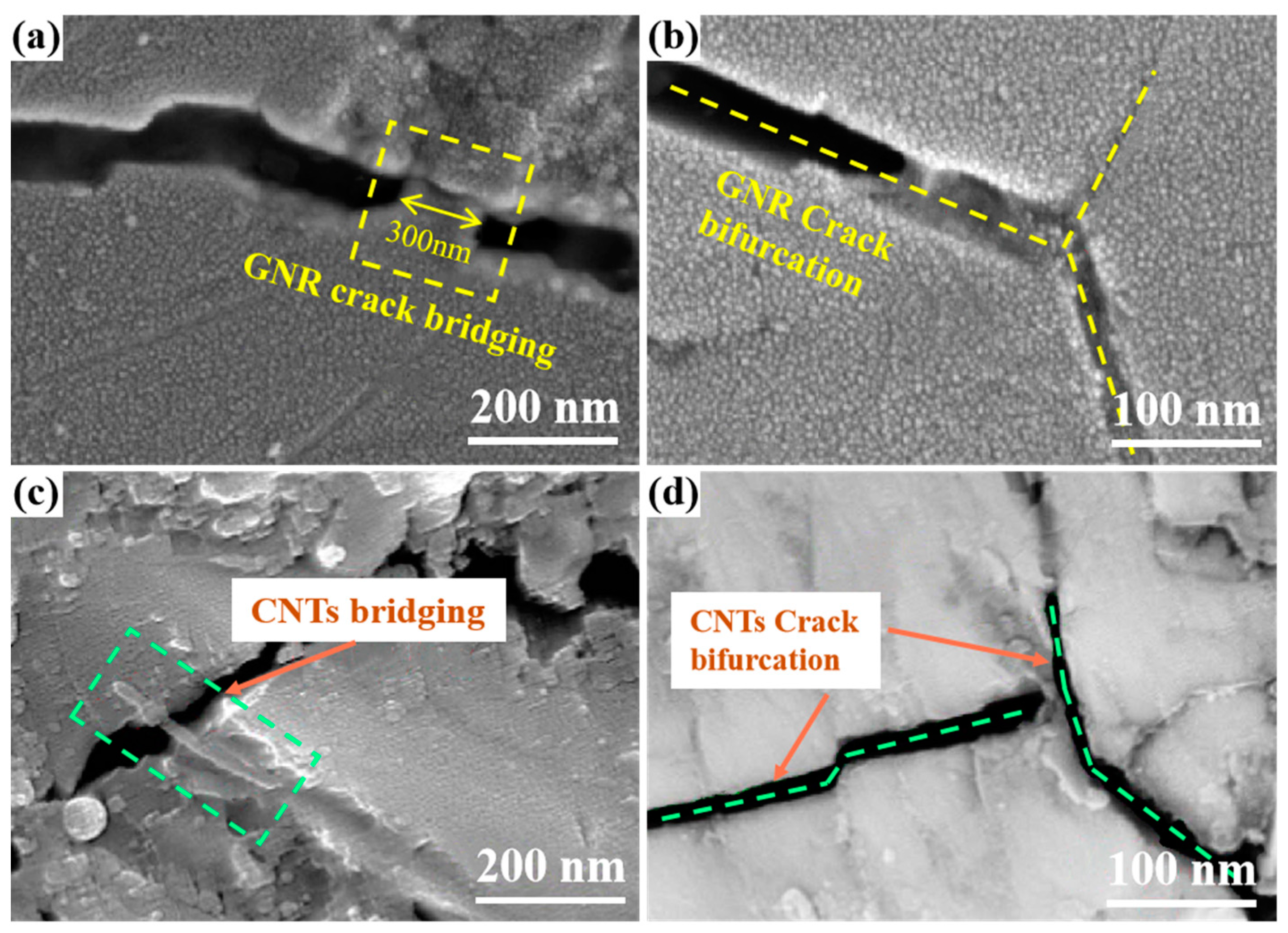
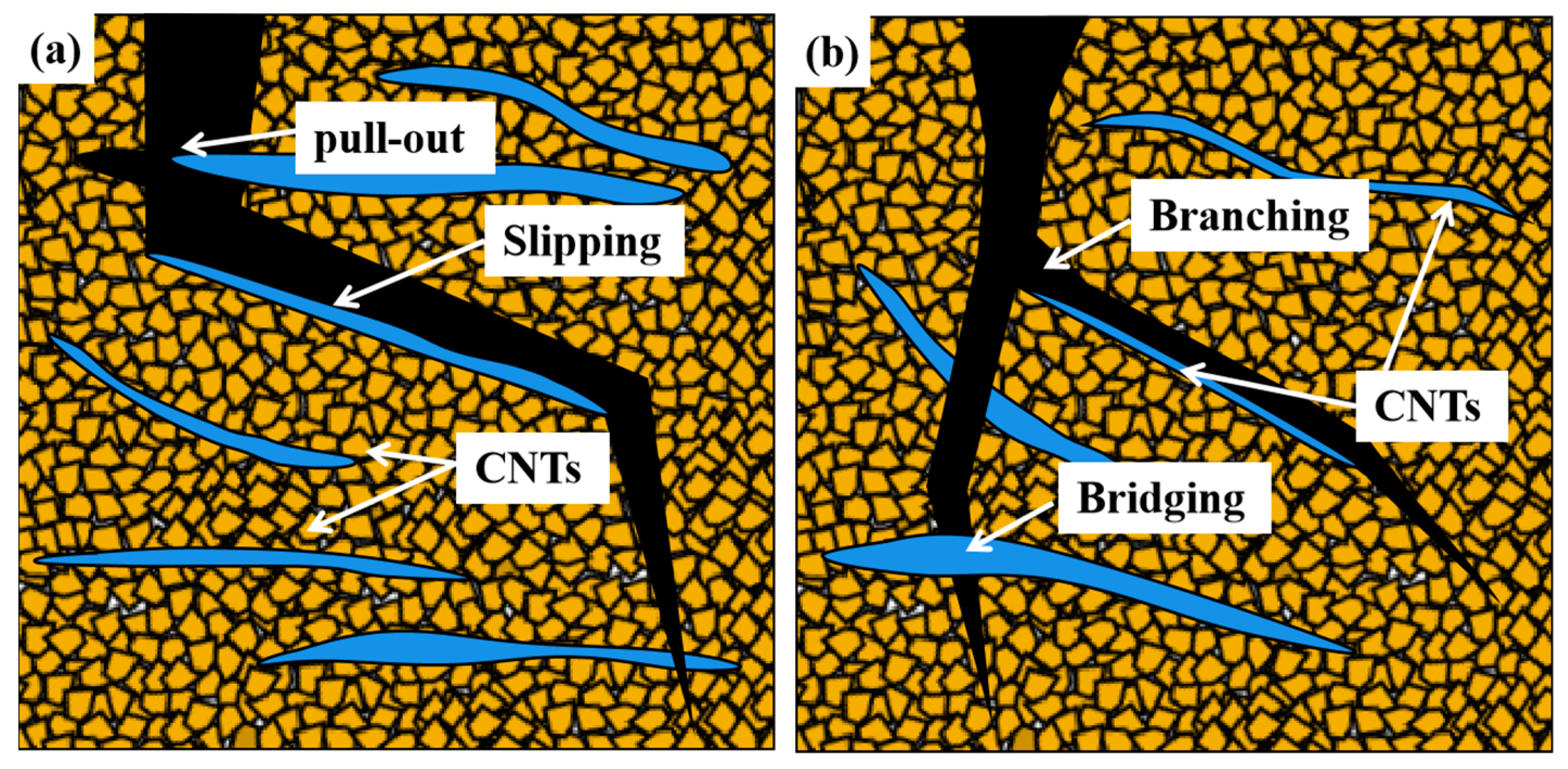
| Material Composition | Processing Conditions (°C/min/MPa) | Material Particle Size (μm) | Relative Density (%) | Vickers Hardness (GPa) | Fracture Toughness (MPa·m1/2) | Flexural Strength (Mpa) | Modulus of Elasticity (GPa) | References |
|---|---|---|---|---|---|---|---|---|
| TiC | SPS, 1600/10/50 | - | 96.1 | 23.6 | - | - | - | [13] |
| TiC-SiC (10 mol.%) | - | 97.3 | 23.0 | - | - | - | ||
| TiC-SiC (25 mol.%) | - | 87.1 | 18.5 | - | - | - | ||
| TiC-SiC (50 mol.%) | - | 75.1 | 7.9 | - | - | - | ||
| TiC | SPS, 1700/10/50 | 0.8 | 96.5 | 23.6 | - | - | - | |
| TiC-SiC (10 mol.%) | 0.5 | 96.6 | 23.0 | - | - | - | ||
| TiC-SiC (25 mol.%) | 0.4 | 96.4 | 17.9 | - | - | - | ||
| TiC-SiC (50 mol.%) | 0.23 | 90.1 | 16.2 | - | - | - | ||
| TiC | SPS, 1800/10/50 | 1 | 94.9 | - | - | - | - | |
| TiC-SiC (10 mol.%) | 0.7 | 96.3 | - | - | - | - | ||
| TiC-SiC (25 mol.%) | 0.5 | 96.1 | - | - | - | - | ||
| TiC-SiC (50 mol.%) | 0.33 | 95.3 | - | - | - | - | ||
| TiC | SPS, 1900/10/50 | 1 | 98.1 | - | - | - | - | |
| TiC-SiC (10 mol.%) | 0.75 | 96.6 | - | - | - | - | ||
| TiC-SiC (25 mol.%) | 0.7 | 96.6 | - | - | - | - | ||
| TiC-SiC (50 mol.%) | 0.38 | 95.7 | - | - | - | - | ||
| TiC | SPS, 1800/5/75 | 0.9 | 95.4 | 24.4 | 1.4 | - | - | |
| TiC-SiC (10 mol.%) | 0.54 | 97.2 | 21.7 | 2.2 | - | - | ||
| TiC-SiC (25 mol.%) | 0.4 | 97.3 | 23.7 | 2.4 | - | - | ||
| TiC-SiC (50 mol.%) | 0.27 | 97.3 | 31.1 | 5.3 | - | - | ||
| TiC | SPS, 1600/5/50 | 5.4 ± 0.7 | 88 | 26.9 ± 1.12 | 3.7 | - | 344.5 | [16] |
| TiC–WC (3.5 wt.%) | 3.9 ± 0.5 | 93 | 28.3 ± 1.85 | 4.2 | - | 351.8 | ||
| TiC–WC (3.5 wt.%)-CNT (2 wt.%) | 2.7 ± 0.7 | 99 | 23.4 ± 2.69 | 8.1 | - | 377.6 | ||
| TiC-WC (3 vol.%) | SPS, 1900/7/40 | - | 99.8 | 28.6 | - | 612 | - | [41] |
| TiC-WC (3 vol.%)-SiCw (10 vol.%) | 94.1 | 11.6 | - | 368 | - | |||
| TiC-WC (3 vol.%)-SiCw (20 vol.%) | 102.5 | 16.1 | - | 694 | - | |||
| TiC | SPS, 1900/7/40 | - | 99.23 | 25.1 | - | 545 | - | [42] |
| TiC-SiCw (10 vol.%) | 98.73 | 24.5 | - | 511 | - | |||
| TiC-SiCw (20 vol.%) | 101.68 | 26.1 | - | 644 | - | |||
| TiC-SiCw (30 vol.%) | 102.95 | 29.0 | - | 612 | - | |||
| TiC | HP, 2000/120/50 | 28.16 | 98.44 | 2111 (HV0.5kg) | - | 410 | - | [43] |
| TiC-SiCw (40 wt.%) | 28.78 | 100 | 2280 (HV0.5kg) | - | 543 | - | ||
| TiC-SiCw (10 vol.%) | SPS, 1800/7/40 | - | 85.9 | 11.3 | - | 289.3 | - | [44] |
| TiC-SiCw (10 vol.%) | SPS, 1900/7/40 | 98.7 | 24.5 | - | 509.6 | - | ||
| TiC-SiCw (10 vol.%) | SPS, 2000/7/40 | 95.1 | 22.6 | - | 468.5 | - | ||
| TiC | HP, 2000/120/50 | 28.16 | 98.4 | 2111 (HV0.5kg) | - | 410 | - | [45] |
| TiC-WC (5 vol.%) | 20.34 | 99.9 | 2359 (HV0.5kg) | - | 491 | - | ||
| TiC-SiC (10 vol.%) | SPS, 1900/7/40 | - | 98.7 | 24.5 | - | 504 | - | [46] |
| TiC-SiC (10 vol.%)-WC (1.5 vol.%) | 99.4 | 22.4 | - | 482 | - | |||
| TiC-SiC (10 vol.%)-WC (3 vol.%) | 94.1 | 11.6 | - | 372 | - | |||
| TiC | SPS, 1900/10/40 | 3.6 | 98.3 | - | 4.3 | - | - | [47] |
| TiC-SiC (14.6 vol.%) | Ti(3.1) SiC(0.45) | 97.9 | - | 5.2 | - | - | ||
| TiC-SiC (27.7 vol.%) | Ti(2.5) SiC(0.43) | 95.6 | - | 4.7 | - | - | ||
| TiC-SiC (39.7 vol.%) | Ti(2.8) SiC(0.46) | 88.8 | - | 4.2 | - | |||
| TiC-SiC (50.6 vol.%) | Ti(2.7) SiC(0.42) | 76.1 | - | - | - | - | ||
| TiC | SPS, 1900/10/40 | - | 95.5 | 3128 (HV0.1kg) | - | 504 | - | [48] |
| TiC–C (5 wt.%) | 90.3 | 2872 (HV0.1kg) | - | 371 | - | |||
| TiC | SPS, 1900/10/40 | - | 95.5 | 3128 (HV0.1kg) | - | 504 | - | [49] |
| TiC–C (5 wt.%) | 100 | 3233 (HV0.1kg) | - | 658 | - | |||
| TiC | SPS, 2100/10/- | - | 98.1 | 3006 (HV0.5kg) | - | - | - | [50] |
| TiC-SiC (30 mol.%) | SPS, 2100/15/- | 92.2 | 2729 (HV0.5kg) | - | - | - | ||
| TiC-SiC (50 mol.%) | SPS, 2100/15/- | 99.1 | 3214 (HV0.5kg) | - | - | - | ||
| TiC | HP, 2000/120/50 | 28.16 | 98.4 | 2111 (HV0.5kg) | - | 410 | - | [51] |
| TiC-SiC (40 vol.%) | 28.78 | 100 | 2280 (HV0.5kg) | - | 543 | - | ||
| TiC-WC (5 vol.%) | 20.34 | 99.9 | 2359 (HV0.5kg) | - | 491 | - | ||
| TiC-SiC (40 vol.%)-WC (5 vol.%) | 22.23 | 100 | 2525 (HV0.5kg) | - | 590 | - | ||
| TiC | SPS, 1600/5/50 | - | 98 | - | - | - | - | [52] |
| TiC–WC (3.5 wt.%) | - | 100 | - | - | - | - | ||
| TiC–WC (5 wt.%) | - | 94 | - | - | - | - | ||
| TiC–WC (10 wt.%) | - | 91 | - | - | - | - | ||
| TiC–WC (3.5 wt.%) | SPS, 1450/5/50 | 2.1 | 98 | 21.9 | 5.1 | 522.5 | - | |
| TiC–WC (3.5 wt.%) | SPS, 1500/5/50 | 2.3 | 99 | 24.8 | 5.4 | 576.6 | - | |
| TiC–WC (3.5 wt.%) | SPS, 1550/5/50 | 2.6 | 100 | 25.2 | 5.8 | 584.4 | - | |
| TiC–WC (3.5 wt.%) | SPS, 1600/5/50 | 3.1 | 100 | 28.2 | 6.3 | 597.9 | - | |
| TiC | SPS, 1600/-/50 | - | - | 32.8 ± 0.8 | - | - | 295 ± 3.4 | [53] |
| TiC–WC (3.5 wt.%) | - | 34.3 ± 0.6 | - | - | 309 ± 13.6 | |||
| TiC–WC (3.5 wt.%)-CNT (2 wt.%) | - | 33.1 ± 1.4 | - | - | 257 ± 12 | |||
| TiC | SPS, 1600/5/50 | 66.6 | 90 | 23.5 | 3.1 | - | 300.1 | [54] |
| TiC–WC (3.5 wt.%) | 51.4 | 94 | 27.9 | 4.2 | - | 328.6 | ||
| TiC–WC (3.5 wt.%)-CNT (2 wt.%) | 32.6 | 99 | 33.6 | 7.4 | - | 428.1 | ||
| TiC | SPS, 1900/10/40 | - | 95.5 | 3128 (HV0.1kg) | - | 504 | - | [55] |
| TiC–graphite (5 wt.%) | 97.1 | 2071 (HV0.1kg) | - | 633 | - | |||
| TiC | SPS, 1900/10/40 | 11.45 | 95.5 | 3128 (HV0.1kg) | - | 504 | - | [56] |
| TiC-h-BN (5 wt.%) | 6.1 | 95.4 | 2914 (HV0.1kg) | - | 429 | - | ||
| TiC–graphite (5 wt.%) | 8.4 | 97.1 | 2071 (HV0.1kg) | - | 633 | - | ||
| TiC-h-BN (5 wt.%)-graphite (5 wt.%) | 6.9 | 93.2 | 2477 (HV0.1kg) | - | 457 | - | ||
| TiC | SPS, 1900/10/40 | - | 95.5 | 3128 (HV0.1kg) | - | 504 | - | [57] |
| TiC–graphite (5 wt.%) | 95.6 | 2703 (HV0.1kg) | - | 532 | - |
Publisher’s Note: MDPI stays neutral with regard to jurisdictional claims in published maps and institutional affiliations. |
© 2021 by the authors. Licensee MDPI, Basel, Switzerland. This article is an open access article distributed under the terms and conditions of the Creative Commons Attribution (CC BY) license (https://creativecommons.org/licenses/by/4.0/).
Share and Cite
Mao, H.; Shen, F.; Zhang, Y.; Wang, J.; Cui, K.; Wang, H.; Lv, T.; Fu, T.; Tan, T. Microstructure and Mechanical Properties of Carbide Reinforced TiC-Based Ultra-High Temperature Ceramics: A Review. Coatings 2021, 11, 1444. https://doi.org/10.3390/coatings11121444
Mao H, Shen F, Zhang Y, Wang J, Cui K, Wang H, Lv T, Fu T, Tan T. Microstructure and Mechanical Properties of Carbide Reinforced TiC-Based Ultra-High Temperature Ceramics: A Review. Coatings. 2021; 11(12):1444. https://doi.org/10.3390/coatings11121444
Chicago/Turabian StyleMao, Haobo, Fuqiang Shen, Yingyi Zhang, Jie Wang, Kunkun Cui, Hong Wang, Tao Lv, Tao Fu, and Tianbiao Tan. 2021. "Microstructure and Mechanical Properties of Carbide Reinforced TiC-Based Ultra-High Temperature Ceramics: A Review" Coatings 11, no. 12: 1444. https://doi.org/10.3390/coatings11121444







